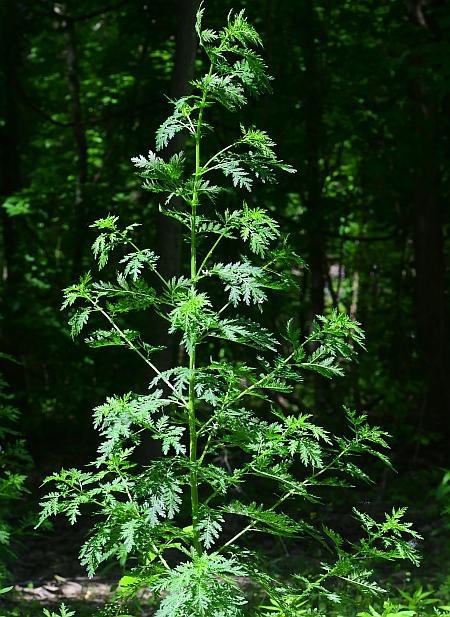Artemisia annua L.
Sweet Wormwood

Introduced
CC = *
CW = 3
MOC = 40
© SRTurner
Artemisia annua L.Sweet Wormwood | |
 |
Introduced CC = * CW = 3 MOC = 40 |
© SRTurner |
|
Family - Asteraceae/Anthemideae Habit - Taprooted annual forb, very aromatic when bruised. Stems - Erect, to 2 m, ridged, glabrous, minutely glandular. Leaves - Alternate, to 10 cm. Leaves near base long-petiolate, often withered at flowering. Upper leaves reduced, short-petiolate to sessile. Leaf blades 1-2 times pinnately lobed or compound, ovate in outline, fernlike, the ultimate segments narrow but not threadlike, glabrous, minutely glandular, strongly aromatic.
Inflorescence - Open, leafy panicles bearing clusters of stalked heads.
Flowers - Heads discoid, with the central florets perfect and the marginal florets perfect or pistillate. Involucre 1.0-1.5 mm long, the bracts in 2 or 3 overlapping rows, glabrous but minutely glandular, with broad, thin, transparent margins and tips. Receptacle convex, naked, lacking bristly hairs. Corollas minute (< 1 mm). Pappus absent.
Fruits - 0.7-0.9 mm long, more or less obovoid, faintly lined, tan to grayish brown, shiny. Flowering - August - November. Habitat - Bottomland forests, riverbanks, lake margins, old fields, railroads, open disturbed areas. Origin - Native to Asia. Lookalikes - Other species of Artemisia. Vegetatively resembles Conium maculatum. Other info. - This plant is found in scattered locations in Missouri, often in close proximity to the major rivers. When young it can resemble Conium maculatum, having frilly, fernlike leaves, but the intense fragrance of the foliage is instantly diagnostic of the Artemisia genus. Wormwoods have been used to prepare beverages such as absinthe, though some might consider the fragrance more appropriate to perfumery than internal consumption. Photographs taken at Klondike County Park, St. Charles County, MO, 7-5-2013; in Washington Riverfront Park, Franklin County, MO, 9-15-2018, 5-28-2020, and 9-19-2020; and near Creve Coeur Lake Park, St. Louis County, 9-26-2019 (SRTurner). |